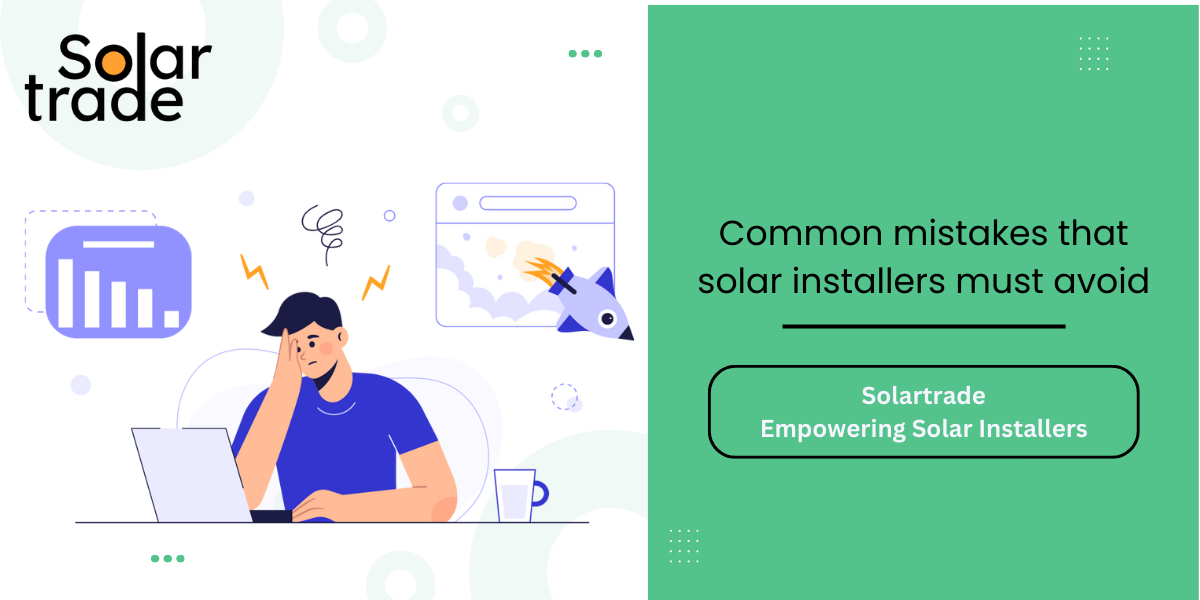
If you are a solar installer, then this article is for you. We all know that solar solutions last for more than 20 years. It means the solar solution that you will install will be a part of your client’s life for a very long time. So you must give them the best experience with their solar solution.
Here in this article we will take you through the most common mistakes that solar installers must avoid. By avoiding these mistakes, you can help your client to be energy independent.
You must know, before quoting your price to the client, you need to educate them about every possibility. If you will educate them, it will generate trust toward you.
What are the 3 common mistakes that solar installers must avoid?
Future planning with solar solutions
You need to educate your client about their increase in power consumption after 5-6 years. If they do not plan ahead of time when developing solar solutions, they may encounter problems later. Thinking about current demands is a common mistake made when planning or installing solar solutions. People rarely consider how their power consumption will increase in the future.
Your client could have children, add more rooms to their home, buy an electric car, or start a home-based business. All of this would result in increased energy consumption. You must educate them about these possibilities.
Check that they have enough space to expand your current setup. If the panels now cover the entire roof, where will they put more panels in the future? Another factor to consider is whether the system is intended to grow. It is not as simple as adding more panels to expand the system. Scaling other components, such as the inverter, is required.
Off-grid or On-grid, which one to choose?
It’s a common misconception that installing a solar power system will cut you off from your city’s power grid.
Solar panels enable you to generate your energy and eliminate the need to pay for grid-supplied electricity. However, you will need a way to store the energy generated by solar panels for later use. If you have access to power lines, you can store this energy in the electric utility system.
So, instead of an off-grid solar system, you want a grid-tied solar system. You can use this technology to generate electricity for your home while also selling it to the state government. In addition, you’ll get a five-year payback period and 20 years of free electricity.
Off-grid solar power systems must rely on a different type of energy storage because they do not have access to power lines. In this situation, battery banks can come in handy. Batteries are expensive, but they are required for an off-grid solution. They consume a significant portion of the return on investment from solar panels (ROI).
As a result, being connected to the grid will assist you in avoiding a costly mistake.
Basic maintenance of solar solution
We all who are associated with the solar industry knows that just by cleaning solar panels regularly, one can enhance the overall efficiency of the solar solution.
Its very important for you as a solar installer to teach your client about how to do the basic maintenance like cleaning the panels or not to disturb the connections. The more you educate the client, the more trust will build and your client might refer you more business.
Solar is a long term investment
Without a doubt, solar energy is not cheap. It’s a big commitment, and the installation is expensive up front. Electricity from the power company, on the other hand, is not cheap, and it will only become more expensive as non-renewable resources run out.
Installing a solar power system will be far more beneficial in the long run. Most grid-connected systems pay for themselves and make you money over the warranty period.
The domestic solar system is a solar system (with a battery backup) that is commonly installed in Indian households. The cost per kW is approximately Rs. 1,00,000. Installing a solar system in such a home could result in annual savings of up to Rs. 8000-9000.
The investment is expected to pay off in 10-11 years, with an estimated return on investment (ROI) of 8%.
Commercial (grid-connected) solar systems on commercial buildings like hospitals, industries, offices, resorts, and other, must have a capacity of 25kW. The cost per kW is approximately Rs. 50,000, with annual savings of approximately Rs. 14,000 rupees. The investment is expected to pay off in 3-4 years, with a 28% return on investment.
These are some very common mistakes that you as a solar installer can avoid and grow your business. See the growth of your business depends on how well you educate your client and help them with their solar energy requirements.